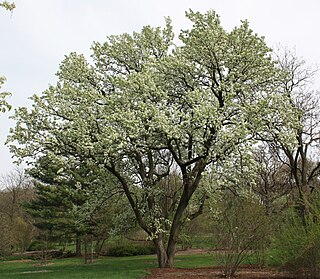
Pears are fruits produced and consumed around the world, growing on a tree and harvested in late Summer into October. The pear tree and shrub are a species of genus Pyrus, in the family Rosaceae, bearing the pomaceous fruit of the same name. Several species of pears are valued for their edible fruit and juices, while others are cultivated as trees.

Fruit tree propagation is usually carried out vegetatively (non-sexually) by grafting or budding a desired variety onto a suitable rootstock.

Fruit tree pruning is the cutting and removing of selected parts of a fruit tree. It spans a number of horticultural techniques. Pruning often means cutting branches back, sometimes removing smaller limbs entirely. It may also mean removal of young shoots, buds, and leaves.
Perry is an alcoholic beverage made from fermented pears, similar to the way cider is made from apples. It has been common for centuries in England, particularly in the Three Counties ; it is also made in parts of South Wales and France, especially Normandy and Anjou. It is also made in Commonwealth countries such as Canada, Australia and New Zealand.

The avocado, a tree likely originating from southcentral Mexico, is classified as a member of the flowering plant family Lauraceae. The fruit of the plant, also called an avocado, is botanically a large berry containing a single large seed.

The quince is the sole member of the genus Cydonia in the family Rosaceae. It is a tree fruit that bears a deciduous pome fruit, similar in appearance to a pear, and is bright golden-yellow when mature. The raw fruit is a source of food. The tree has been grown by landscape architects for its attractive pale pink blossoms and other ornamental qualities.

Pollination of fruit trees is required to produce seeds with surrounding fruit. It is the process of moving pollen from the anther to the stigma, either in the same flower or in another flower. Some tree species, including many fruit trees, do not produce fruit from self-pollination, so pollinizer trees are planted in orchards.

In botany and horticulture, parthenocarpy is the natural or artificially induced production of fruit without fertilisation of ovules, which makes the fruit seedless. Stenospermocarpy may also produce apparently seedless fruit, but the seeds are actually aborted while they are still small. Parthenocarpy occasionally occurs as a mutation in nature; if it affects every flower the plant can no longer sexually reproduce but might be able to propagate by apomixis or by vegetative means. Examples of this include many citrus varieties that undergo nucellar embryony for reproduction, instead of solely sexual reproduction, and can yield seedless fruits.

Pyrus calleryana, or the Callery pear, is a species of pear tree native to China and Vietnam, in the family Rosaceae. It is most commonly known for its cultivar 'Bradford', widely planted throughout the United States and increasingly regarded as an invasive species.

The damson or damson plum, also archaically called the "damascene", is an edible drupaceous fruit, a subspecies of the plum tree. Varieties of insititia are found across Europe, but the name damson is derived from and most commonly applied to forms that are native to Great Britain. Damsons are relatively small ovoid plum-like fruit with a distinctive, somewhat astringent taste, and are widely used for culinary purposes, particularly in fruit preserves and jams.

Pyrus communis, known as the European pear or common pear, is a species of pear native to central and eastern Europe and southwest Asia.

The Williams' bon chrétien pear, commonly called the Williams pear, or the Bartlett pear in the United States and Canada, is the most commonly grown variety of pear in most countries outside Asia.

Ficus carica is an Asian species of flowering plant in the mulberry family, known as the common fig. It is the source of the fruit also called the fig and as such is an important crop in those areas where it is grown commercially. Native to the Mediterranean and western Asia, it has been sought out and cultivated since ancient times and is now widely grown throughout the world, both for its fruit and as an ornamental plant. The species has become naturalized in scattered locations in Asia and North America.
The 'Laxton's Superb' is an apple cultivar that was developed in England in 1897. It is a cross breed between 'Wyken Pippin' and 'Cox's Orange Pippin'. It is a British apple with a green color and a dull red flush. It is a firm-textured dessert apple. The fruit is well known for its sweet and aromatic taste which is likened to the parent species it is derived from, the 'Cox's Orange Pippin'.

A Conference pear is a variety of pear.

Winston is an English cultivar of domesticated apple which was first named Winter King because of its availability in the winter, but was renamed as Winston in 1944 or in 1945, after Winston Churchill.

Stella is a cultivar of cherry developed in British Columbia, Canada. It is notable as the first self-fertile sweet cherry to be named. It has been awarded the Royal Horticultural Society's Award of Garden Merit.

Lapins is a cultivar of cherry. It is a hybrid of the Van and Stella cultivars. It has been awarded the Royal Horticultural Society's Award of Garden Merit.
The Sweetheart cherry is a cultivar of cherry. It is a hybrid of the Van and Newstar cultivars first developed in Canada.

The Doyenné du Comice is a French pear variety first cultivated in the 19th century.

















